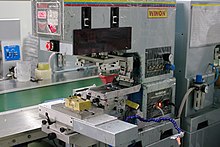Light industry
This article needs additional citations for verification. (April 2018) |

Light industry are industries that usually are less capital-intensive than heavy industry and are more consumer-oriented than business-oriented, as they typically produce smaller consumer goods. Most light industry products are produced for end users rather than as intermediates for use by other industries. Light industry facilities typically have less environmental impact than those associated with heavy industry. For that reason zoning laws are more likely to permit light industry near residential areas.[1]
One definition states that light industry is a "manufacturing activity that uses moderate amounts of partially processed materials to produce items of relatively high value per unit weight".[2]
Characteristics[]
Light industries require fewer raw materials, space and power. While light industry typically causes little pollution, particularly compared to heavy industry, some light industry can cause significant pollution or risk of contamination. For example, electronics manufacturing, itself often a light industry, can create potentially harmful levels of lead or chemical wastes in soil without proper handling of solder and waste products (such as cleaning and degreasing agents used in manufacture).
Industry sectors[]
- Food industry

- Paper making
- Plastic
- Leather industry
- Textiles
- Wood
- Household electric appliances

General use products[]
- Kitchen and dining products
- Beauty and personal care
- Home textiles
- Cleaning and storage
- Clock, watch and eyewear
- Gardening and entertainment
- Baby goods
- Household sundries
- Advertising and packaging
References[]
- ^ O'Sullivan, Arthur (2003). Economics: Principles in Action. Upper Saddle River, New Jersey 07458: Pearson Prentice Hall. pp. 493. ISBN 0-13-063085-3.
{{cite book}}: CS1 maint: location (link) - ^ "Light Industry Law And Legal Definition". US Legal. Retrieved 26 Apr 2018.
- Industries (economics)
- Economics and finance stubs